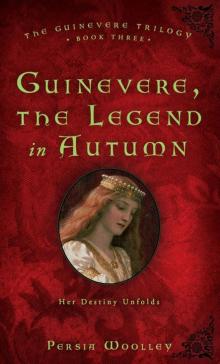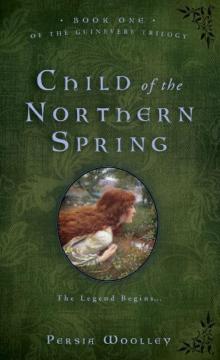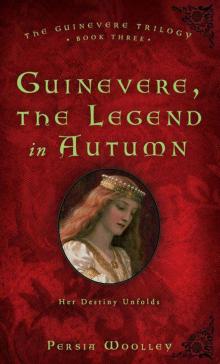- Home
- Persia Woolley
Guinevere: The Legend in Autumn
Guinevere: The Legend in Autumn Read online
Copyright
Copyright © 2011 by Persia Woolley
Cover and internal design © 2011 by Sourcebooks, Inc.
Cover design by Susan Zucker
Cover images © The Accolade, 1901 (oil on canvas), Leighton, Edmund Blair (1853-1922) / Private Collection / Photo © Christie’s Images / The Bridgeman Art Library International; cinnamonsaturday/iStockphoto.com; robynmac/iStockphoto.com; Angel_1978/iStockphoto.com
Sourcebooks and the colophon are registered trademarks of Sourcebooks, Inc.
All rights reserved. No part of this book may be reproduced in any form or by any electronic or mechanical means including information storage and retrieval systems—except in the case of brief quotations embodied in critical articles or reviews—without permission in writing from its publisher, Sourcebooks, Inc.
The characters and events portrayed in this book are fictitious or are used fictitiously. Any similarity to real persons, living or dead, is purely coincidental and not intended by the author.
Published by Sourcebooks Landmark, an imprint of Sourcebooks, Inc.
P.O. Box 4410, Naperville, Illinois 60567-4410
(630) 961-3900
Fax: (630) 961-2168
www.sourcebooks.com
Originally published in 1993 by Pocket Books.
Library of Congress Cataloging-in-Publication Data
Woolley, Persia,
Guinevere, the legend in Autumn / by Persia Woolley.
p. cm. — (The Guinevere trilogy ; bk. 3)
(pbk. : alk. paper) 1. Guenevere, Queen (Legendary character)—Fiction. 2. Arthurian romances—Adaptations. 3. Queens—Great Britain—Fiction. I. Title.
PS3573.O68G85 2011
813’.54—dc23
2011031257
Contents
Front Cover
Title Page
Copyright
Map of King Arthur’s Britain
Cast of Characters
Preface
Prologue
Chapter I
Chapter II
Chapter III
Chapter IV
Chapter V
Chapter VI
Chapter VII
Chapter VIII
Chapter IX
Chapter X
Chapter XI
Chapter XII
Chapter XIII
Chapter XIV
Chapter XV
Chapter XVI
Chapter XVII
Chapter XVIII
Chapter XIX
Chapter XX
Chapter XXI
Chapter XXII
Chapter XXIII
Chapter XXIV
Chapter XXV
Chapter XXVI
Chapter XXVII
Chapter XXVIII
Chapter XXIX
Chapter XXX
Chapter XXXI
Chapter XXXII
Chapter XXXIII
Chapter XXXIV
Chapter XXXV
Chapter XXXVI
Chapter XXXVII
Epilogue
An excerpt from Queen of the Summer Stars
Reading Group Guide
About the Author
Back Cover
To the children and family who understood that a deadline sometimes cut Christmas down to a phone call rather than a visit;
to my father, William C. Higman;
and to my high school teacher, John Chaney, whose comment “Of course you can” led to my tackling this entire project.
Cast of Characters
House of Pendragon
Arthur—King of Logres, High King of Britain
Guinevere of Rheged—Arthur’s wife, High Queen of Britain
Mordred—Arthur’s son
Igraine—Arthur’s mother, wife of Uther, High King of Britain
Morgause—daughter of Igraine by her first husband, Gorlois
Morgan le Fey—daughter of Igraine by her first husband, Gorlois
Cei—Arthur’s foster brother and Seneschal of the Realm
Bedivere—Arthur’s foster brother and wise counselor
House of Orkney
Morgause—widow of King Lot, half sister of Arthur
Gawain—son of Morgause
Gaheris—son of Morgause
Agravain—son of Morgause
Gareth—son of Morgause
Mordred—son of Morgause
House of Northumbria
Urien—King of Northumbria, husband of Morgan
Morgan le Fey—half sister of Arthur, wife of Urien, High Priestess and Lady of the Lake
Uwain—son of Morgan and Urien
Brittany Faction
Lancelot of the Lake—Arthur’s best friend and lieutenant
Ector de Mans—Lancelot’s half brother
Bors—brother of Lionel and cousin of Lancelot
Lionel—brother of Bors and cousin of Lancelot
Belliance—protégé of Lancelot
Melias—protégé of Lancelot
Lavaine—protégé of Lancelot
Kanahins—protégé of Lancelot
Nerovens—protégé of Lancelot
Urr—protégé of Lancelot
House of Pellinore
Pellinore—warlord of the Wrekin
Lamorak—Pellinore’s eldest son in wedlock
Perceval—Pellinore’s youngest son in wedlock
Amide—one of Pellinore’s many illegitimate children
Other Members of the Round Table Fellowship
Accolon of Gaul—Morgan le Fey’s lover
Agricola—Roman King of Demetia
Vortipor—arrogant nephew of Agricola
Bagdemagus—warlord of Dorset
Cador—Duke of Cornwall
Constantine—Cador’s son and successor
Colgrevance—warrior friend of Gawain’s from the Continent
Dinadin—Tristan’s best friend
Florence—warrior friend of Agravain
Geraint—King of Devon, husband of Enid
Gingalin—son of Gawain and Ragnell
Griflet—Master of the Kennel and husband of Frieda
Ironside—aging warrior
Lovel—warrior friend of Agravain
Lucan—Arthur’s Gatekeeper and butler
Palomides—slave-born Arab, lover of Isolde
Pelleas—husband of Nimue
Petroc—warlord from Devon
House of Carbonek
Pellam—wounded King of the Waste Land
Elaine—his beautiful daughter, lover of Lancelot
Galahad—son of Elaine and Lancelot
House of Cornwall
Mark—King of Cornwall
Isolde—Mark’s child-bride from Ireland
Tristan—nephew to Mark, Isolde’s lover
Women of Camelot
Brigit—Irish foster sister to Guinevere
Brisane—governess to Elaine of Carbonek
Enid—sharp-tongued lady-in-waiting, wife of Geraint
Lynette—daughter of Ground’s Keeper in London, wife of Gareth
Vinnie—Roman matron in charge of ladies-in-waiting
Various Heads of State
Anastasius—Emperor in Constantinople
Clovis—King of the Franks
Theodoric the Great—Ostrogoth King of Italy
Other Characters
Mr. and Mrs. Badger—gardener and housekeeper at Joyous Gard
Bercilak—Charcoal burner and prankster who is one of the Ancient Ones, half-civilized, half-wildman
Cathbad—Druid who was Guinevere’s childhood teacher
Cerdic—Saxon leader who challenged Arthur at Mount Badon
Cynric—Cerdic’s son, kept as
a peace-hostage after the Battle of Mount Badon
Dagonet—Arthur’s Court Jester
Frieda—Saxon milk-maid, wife of Griflet
Gildas—past suitor of Gwen, monk and student of Illtud
The Green Man—an Ancient God who may or may not be a figment of everyone’s imagination
Gwyn of Neath—horsebreeder and builder of the Hall on Glastonbury’s Tor
Gwynlliw—representative of warlords in Dorset hill-forts
Illtud—Prince/warrior who became a monk
Kimmins—crofter in the Cheviot Hills
Maelgwn—Guinevere’s cousin, King of Gwynedd
Merlin—Arthur’s tutor and mentor, the Mage of Britain
Nimue—Priestess and protégé of Merlin, wife of Pelleas
Ragnell—leader of nomadic Ancient Ones, lover of Gawain
Riderich—Arthur’s bard
Taliesin—peasant boy who becomes a famous bard
Wehha the Swede—leader of East Anglian Federates
Wuffa—Wehha’s son
Yder—brother of Gwyn of Neath
Preface
I love prefaces because they are the author’s chance to say to the reader, “Here’s what I’ve been thinking about for a book—if you’re interested, let’s explore the matter together.”
In this particular case, my idea is to explore the stories of King Arthur’s Camelot from a realistic point of view, looking for the character types and adventures that could have planted the seed from which the legend grew.
This business of looking for the human story behind a legendary tale is called “euhemerism,” and a number of other authors have employed it over the years, from Mary Renault to Parke Godwin and Morgan Llywelyn. It has also been used by archeologists, the classic example being Schliemann’s discovery of the site of Troy as a result of his treating The Iliad as a historical rather than fictional account of the Trojan War.
Because of my interest in the reality behind the myth, I do not write fantasy (and in spite of the covers you may find on my books, I don’t write “women’s romance” either). There’s plenty of superstition among my characters, and more than enough love to go around, but if you are looking for a sword-and-sorcery epic, this is certainly not the book for you.
On the other hand, if you want a smashing good story filled with archetypical characters going off on great quests, following noble causes, espousing the need for honor and courtesy, and developing into a fine Fellowship—as well as engaging in duplicity, chicanery, villainy, incest, matricide, and terrible betrayals, both personal and political…you’ll find the tales of Arthur’s Round Table have been providing all this and more for hundreds of years. I know of no other single story cycle which offers a broader range of characters and endeavors, or a deeper look into the troubled heart of humanity.
This is one of the reasons I have chosen to tell the tale through the eyes of Arthur’s wife, Guinevere. It seems clear that although women look at the same events as men, they see very different things. In the past men told tales that focused on who was the bloodiest, who was the bravest, and who made off with the loot (or the crown or the lady), whereas women tended to tell who did what to whom, why they did it, and how it will affect the rest of the tribe. I felt it was time we took a new look at this old story through the eyes of a real woman, and who better to see, know, and understand the characters of the Round Table than the much-loved Queen at the heart of it?
Although it has recently been popular to make Guinevere a scapegoat for the fall of the Round Table, my research back through the literature of the Matter of Britain (as the collected stories of Arthur are called) clearly showed that whatever else was laid at Gwen’s doorstep, she was always seen as the gracious and caring Queen. In the medieval stories she is sometimes referred to as “Guinevere the gay” and is credited with bringing high spirits and playfulness to the Court. At no point does Arthur consider putting her aside because she can’t have children, and it is clear that there are almost as many who side with her and Lancelot as with Arthur at the end. Naturally I have built on that and (I hope) made her a lively and admirable character in her own right.
This is the last volume of a trilogy, and while each book stands alone, I’d like to summarize the first two for those who haven’t read them.
The first book, Child of the Northern Spring, details Arthur’s rise to power and Gwen’s childhood. I deliberately made her a feisty northern girl who doesn’t see any reason why she has to learn to wear dresses, speak Latin, and go south to marry that king. By giving her a rough, tomboy background, I made sure she’d be looking at her new husband’s world with fresh eyes.
In Queen of the Summer Stars, Gwen gradually grows into her role of queen and co-ruler with Arthur as the Round Table develops and the classic characters gather at Camelot’s Court.
Now, in this book, Gwen and the rest of the cast each confront his or her moira—or fate—and, like human beings everywhere, try to do the best they can under the circumstances they find themselves in. Given the full range of characters and the scope of their dreams or disillusionments, it’s a very heady mixture.
If Arthur and Guinevere lived, it would have been sometime between AD 450 and 550, during the era commonly referred to as the Dark Ages. This was a period of vast upheaval and great excitement, when the Roman world was being challenged—and in some cases swallowed up—by the barbarian societies that were sweeping over it. Most of Europe was in political chaos as wave after wave of Goths, Visigoths, Vandals, Alans, Franks, Angles, Saxons, and various other uncivilized (literally, “non-city dwelling”) peoples moved westward, each displacing the tribes in front of them. Both historically and traditionally, the only serious effort made to stop them was that mounted by the Britons, and who is to say that their leader was not a noble king named Arthur Pendragon, who seated his allies in a circle and tried to salvage some semblance of civilized behavior from the tide of barbarian anarchy that was flooding Europe.
In the end, of course, it was the barbaric Saxons who won, driving the remnants of Arthur’s Britons into the Welsh mountains where they kept alive the story of their last great king in folktales for some five hundred years. When these were eventually discovered by the French bards on the Continent, they became the source for all sorts of improvising, and the Arthurian Romances were born. These stories were written for and enjoyed by a medieval Christian audience and provide many of the tales that we think of as traditional today. (It is also this French connection that leads everyone to think of the characters as wearing shiny fourteenth-century armor and high, peaked hats with veils, though the real people would probably have been wearing mail and tunics or even togas.)
But even as the new Christian stories grew, the bards were incorporating shadows of the culture that had surrounded the original Arthur, probably without even realizing it. For instance, the old Celts were, according to the historians of Caesar’s time, head-hunters. Nowhere is it actually said that Arthur and his crew indulged in that practice, but anyone who reads Malory, for instance, can’t help but notice how many times one of the heroes whacks off someone’s head and goes running off with it.
Then, too, fifth-century Christianity took several different forms. In Rome, the church hierarchy was based on the urban political structure—many laymen looked to a few priests who looked to their single local bishop, just as plebians looked to senators who looked to the emperor or king. But in both Britain and Ireland, where Celtic Christianity flourished, there were few cities, and the religion evolved around individual holy men who wandered the countryside, like St. Patrick. The prevalence of hermits in the Arthurian stories may well be a shadow of that Dark Age time. By the same token, the Grail Quest, which originated in British stories, reflects the individual’s search for meaning rather than acceptance of Church-promoted dogma. Interestingly, the Church has never accepted the Grail story.
People often ask me how much research I do. The answer is, a lot. I’ve made five trips to Britain, both
to explore the land and to collect books on flora and fauna. I’ve hiked innumerable Roman ruins, on the assumption that if I can still see them in the twentieth century, Gwen would have seen them in the sixth; stood on the remains of ancient hill-forts and tried to imagine the layout of thatched roundhouses and square, timbered halls; and mined legend, archaeology, and common sense for explanations of why various characters did what they did in the legends.
There are a few oddities I’d like to clear up. For instance, the eulogy of Urien which I have given to Taliesin may, or may not, have been composed by a different bard of the same era. However, it so eloquently captures the loss felt by the followers of a well-loved warlord, I decided to include it along with excerpts from Taliesin’s Battle of the Trees and The Spoils of Annwn.
Sometimes research puts the author in a quandary. For example, the Cheviot Hills of Northumbria have been famous as rounded, wind-swept grasslands for roughly a thousand years—but in the time I am writing about, they would have been covered with forest. Whenever I came up against such conflicts, I tended to go with what the modem reader would know or understand. In the same way, I have used modern place names rather than the old Roman names, simply because they are easier for the contemporary reader to follow.
In some cases I’ve given a complimentary nod not only to the medieval Romances of Arthur, but also to earlier sources of a particular story. The tale of Uwain is one such case. He is often called the Knight of the Lion because of having cured a lion who was bitten by an adder, after which the creature was his friend for life. Clearly lions did not inhabit Europe during the sixth century, but I used that little reference to make him a veterinarian as well as a warlord and paid quiet homage to the first-century version of the lion story by including the detail of a thorn that Uwain removes.
Over the centuries many a bard has earned a good dinner by telling the stories of Arthur and Guinevere. I probably owe a debt to every one of them, but in particular I would like to mention those whose recent works have specifically inspired this present volume. First off is Phyllis Ann Karr, who so graphically portrayed Mordred’s heartache and Cei’s stoicism in her wonderful novel, Idylls of the Queen. I also found The King Arthur Companion, which she compiled with such wit and erudition, to be invaluable.

 Queen of the Summer Stars: Book Two of the Guinevere Trilogy
Queen of the Summer Stars: Book Two of the Guinevere Trilogy Guinevere, the Legend in Autumn: Book Three of the Guinevere Trilogy
Guinevere, the Legend in Autumn: Book Three of the Guinevere Trilogy Child of the Northern Spring (Guinevere Trilogy)
Child of the Northern Spring (Guinevere Trilogy) Guinevere: The Legend in Autumn
Guinevere: The Legend in Autumn Queen of the Summer Stars
Queen of the Summer Stars